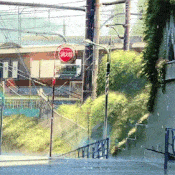|
Also fwiw in China hardly anyone bikes anymore but there's plenty of motorcycles or their equivalents, and that's a country thats much more similar to the US than a small European nation.
|
|
|
|

|
| # ? May 27, 2024 09:28 |
|
ComradeCosmobot posted:It won't work if you've got more than two bags, but they do make panniers for a reason. If I'm only buying two bags worth of groceries I've wasted my time.
|
|
|
|
Get a bike trailer?
|
|
|
|
Facebook has been blowing up with articles about the Sierra Nevada snowpack being at a 500-year low. http://www.latimes.com/science/sciencenow/la-sci-sn-snowpack-20150911-story.html Given how things are looking for snowpack this winter, it seems like things are only gonna get worse.
|
|
|
|
e_angst posted:Facebook has been blowing up with articles about the Sierra Nevada snowpack being at a 500-year low. The 500-year figure is a bit misleading, because California has been in a 500-year wet period, so it's not really a 500-year low, it's more of a "Return to the historically dry climate typical of California during the last 10,000 years".
|
|
|
|
Hitlers Gay Secret posted:If I'm only buying two bags worth of groceries I've wasted my time. Copperhound linked the solution to your grocery problem like 10 posts up. Here it is again: http://www.christianiabikes.com/en/
|
|
|
|
BattleHamster posted:Copperhound linked the solution to your grocery problem like 10 posts up. Ok, but how are you gonna keep all your frozen pizzas cold until you get home?
|
|
|
|
Space-Bird posted:Ok, but how are you gonna keep all your frozen pizzas cold until you get home? You can put a cooler in the box and then put the pizzas in the cooler.
|
|
|
|
My only issue with that bike is what the hell do I do when I have to go downhill with my groceries. That bike might work in Denmark, but not in the Rocky Mountains.
|
|
|
|
You're moving the goal posts. A vast majority of population centers in the US are relatively flat.
|
|
|
|
BattleHamster posted:You can put a cooler in the box and then put the pizzas in the cooler. But what if you also have to stop off at Chick-Fil-A and need to keep those chicken sandwiches all warm and toasty too? Surely you can't keep those frozen pizzas cool AND keep those chicken sandwiches warm!
|
|
|
|
I can't believe I have to wait for the fedex man to ride his Schwinn from New Jersey to Sevastopol to make good on my amazon order. These cyclists have gone too far.
|
|
|
|
CopperHound posted:You're moving the goal posts. A vast majority of population centers in the US are relatively flat. But I don't live in those population centers.
|
|
|
|
Bikes won't replace cars entirely, that's dumb. But in any area that's not exurban or rural they can be a good way to get around for a large percentage of trips. The aim is to balance transportation modes, not obliterate the ones we don't personally like.FCKGW posted:ok but what if im fat Leperflesh posted:We live in a Wal*Mart country. The vast majority of people buy in bulk to save money. You are talking about a lifestyle that is much more expensive than the American standard. Arsenic Lupin posted:It's worth pointing out that Holland is flat. That means grandmas don't have to go up 30-degree hills with their sacks of groceries. It is also much more thickly settled than much of the U.S. People in, say, Atlanta outer-ring suburbs, don't live near a supermarket, thanks to zoning. They don't live near their work thanks to urban sprawl. Most American cities as of 2015 are designed for long-distance travel with cars. It's not as straightforward as "build protected bike lanes and they will come". There is also the issue of winter travel. Until global warming does away with snowstorms, a slushy Tahoe street turned to glare ice is more unsafe for a bike than for a much-heavier car. A car is much, much more comfortable for travelling through a pelting (assuming El Nino does its thing) California winter rainstorm. Hitlers Gay Secret posted:If I'm only buying two bags worth of groceries I've wasted my time. Space-Bird posted:Ok, but how are you gonna keep all your frozen pizzas cold until you get home? Germany has a mode share for bikes of ~10%, I think that would be a healthy number to aim for in the US. edit: Even in SF, there are plenty of parts of the city where the hills aren't that bad: https://www.google.com/maps/place/S...076adff!5m1!1e4 Cicero fucked around with this message at 18:47 on Sep 15, 2015 |
|
|
|
CopperHound posted:You're moving the goal posts. A vast majority of population centers in the US are relatively flat. Are we talking about California in the California thread? Why I never!
|
|
|
|
Trabisnikof posted:Are we talking about California in the California thread? Why I never!
|
|
|
|
Cicero posted:This is false. You're exaggerating how low-density most of America is. Most people don't live 5+ miles away from any shops or schools. People in exurbs or rural areas might, but that's not most Americans. Biking for a good percentage of trips is realistic for most Americans, even given existing density, IF there was good infrastructure. OK. I don't have easily-accessible data on this (which leads me to believe you don't either). I think it's fine and good that you love bicycles but I think your laser-like focus on bicycles as an important solution to reducing California's CO2 output (which is where we got started, remember: legislation mandating a huge reduction in transportation fuel use) is unhelpful. Our infrastructure, including the way our urban and suburban environments are designed, doesn't support bicycling the same way that European infrastructure does. We should add bike lanes where they make sense, and do what we can to encourage bringing bikes on commute rail (except that commute rail systems operating at capacity, like BART, simply don't have room for bicyclists to bring their bikes on board during commute hours), and so forth. But it's not going to help very much. Improving fuel economy by like 10% would be far more effective.
|
|
|
|
Leperflesh posted:OK. I don't have easily-accessible data on this (which leads me to believe you don't either). I think it's fine and good that you love bicycles but I think your laser-like focus on bicycles as an important solution to reducing California's CO2 output (which is where we got started, remember: legislation mandating a huge reduction in transportation fuel use) is unhelpful. quote:50% in 15 years does sound too aggressive, but I think 25% in 15 years could be doable between fuel efficiency improvements (including electric cars) and transit/bike improvements. I'm well aware that serious CO2 reduction will require attacking the problem from multiple angles. It sounds like you're arguing with a strawman.
|
|
|
|
Here's some info on SNAP users:quote:For example, among SNAP households, the nearest store was, on average, 2.0 miles from the household, but the store primarily used for grocery shopping was, on average, 3.4 miles from the household. Similar patterns hold for WIC participating and food-insecure households and for households that use someone else’s car or other forms of transportation to get to the grocery store. quote:The vast majority of households, 88 percent, use their own vehicle to get to the store where they do their main grocery shopping. The percentage of SNAP and food-insecure households who use their own vehicle to get to the grocery store is lower. Makes sense to me, because I know I don't go to the "nearest" 4 grocery stores because they suck even worse than the safeway further away.
|
|
|
|
quote:Overall, households are, on average, 2.1 miles from the nearest SNAP-authorized supermarket or super- center, but their usual store is 3.8 miles away. quote:SNAP households are, on average, just under 2 miles from the nearest SNAP-authorized supermarket or supercenter but travel 3.4 miles, on average, to the store where they do their primary shopping. You also have to figure that, if we did support further transit/biking improvements, along with that you would gradually see average density go up and average store distance fall. We're not stuck with current levels of density forever. Cicero fucked around with this message at 19:29 on Sep 15, 2015 |
|
|
|
Cicero posted:3.4/3.8 miles isn't that bad of a biking distance. That's what, 15-20 minutes? Also, if it's a mean, then it's going to be skewed by the really long trips, with a shorter median. And some people might prefer to go to the closer stores on bikes vs far stores in cars if the infrastructure made it safe. Lets do that math. Lets say that you can fit everything your family needs for the week in only 2 loads on a bike (that's very very pro-bike I doubt most families with kids could do it in 2 loads). 20 minutes each way rather than 5, so an half-hour in transit alone each trip. Plus you've got to add a second trip, and being crazy generous that you only spend 1 hour in the store, that comes to and extra 2 hours on groceries each week. I can see a lot of families that would have to sacrifice parts of their limited free time to buy groceries via bike. That and/or go to a store that they prefer less (and potentially missing ingredients) just to reduce a tiny, tiny, tiny fraction of co2 emissions. Talking about increasing density and moving stores closer in neighborhoods is sadly a pipe dream for many communities and would still take 20+ years. On another topic, what did this thread think of the Redevelopment Agencies before they were dissolved?
|
|
|
|
Trabisnikof posted:Lets do that math. Lets say that you can fit everything your family needs for the week in only 2 loads on a bike (that's very very pro-bike I doubt most families with kids could do it in 2 loads). 20 minutes each way rather than 5, so an half-hour in transit alone each trip. Plus you've got to add a second trip, and being crazy generous that you only spend 1 hour in the store, that comes to and extra 2 hours on groceries each week. - During that hour that you 'lost', you're exercising, something most Americans desperately need. - Bikes are cheaper than cars. Relying on bikes more means you can save more money, and an emergency fund is also something most Americans desperately need. quote:(that's very very pro-bike I doubt most families with kids could do it in 2 loads) quote:I can see a lot of families that would have to sacrifice parts of their limited free time to buy groceries via bike. That and/or go to a store that they prefer less (and potentially missing ingredients) just to reduce a tiny, tiny, tiny fraction of co2 emissions. quote:Talking about increasing density and moving stores closer in neighborhoods is sadly a pipe dream for many communities and would still take 20+ years. Cicero fucked around with this message at 19:56 on Sep 15, 2015 |
|
|
|
Cicero posted:These are bad excuses. Nobody is suggesting this will change overnight. Building infrastructure takes time. The only really problematic issue here is hills for some cities, and even then you could just, like, build bike infrastructure for the parts of the city that don't have huge hills. "the parts of the city that don't have huge hills" Have you been to San Francisco? Or Berkeley? Or looked at a contour map of the Bay Area? * How often do people typically change jobs nowadays? I'm in high-tech, so my viewpoint is skewed. " biking is cheaper, healthier, and potentially more pleasant," Again, rainy winters. For some people, snowy winters. Heat waves. The Hell I'd have ridden a bicycle last week, with temperatures in the 90s-100s, and that's only one week out of the summer. Leaving aside the health issues, most employers don't provide showers for funky post-exercise employees. If I commuted by bicycle, I would also need a car to get me from place to place on all the days when the weather is unfavorable. We have now upped the money requirement to a bike *and* a car. Mass transit infrastructure helps a lot more people than bicycling infrastructure. Bicycling infrastructure, although awesome as a thing, doesn't help the disabled, the elderly and fragile, the children. Many, many places no longer have neighborhood schools you can easily bike to; my kids' middle school was 2 miles uphill from our home. If you really want to maximize people's carless access to the world they live in, put in a reliable bus system with frequent stops, feeding a rail system on decent tracks. Which costs $$$$$. Arsenic Lupin fucked around with this message at 20:08 on Sep 15, 2015 |
|
|
|
What percentage of an average American's driving is grocery shopping, anyway? Surely far more miles are driven for commuting, and - on weekends - every other sort of shopping, entertainment trips, and vacation driving?
|
|
|
|
I like how people think the only way to reduce miles is to stop driving altogether. I bike to work but I drive to do errands that require hauling stuff because cars are very well suited for that.
|
|
|
|
Arsenic Lupin posted:Just how much of California's housing structure are you planning to rebuild? You're gonna have to nuke the Bay Area to rebuild it in a bike-friendly way, with shopping and jobs* near everybody's homes. quote:"the parts of the city that don't have huge hills" Have you been to San Francisco? Or Berkeley? Or looked at a contour map of the Bay Area? As for Berkeley, it looks like the majority of the more densely-populated areas are relatively flat: https://www.google.com/maps/place/B...675e993!5m1!1e4
|
|
|
|
Cicero posted:Yes? Look man, I'm not saying every city could hit Amsterdam-levels of biking. I'm just saying they could do a lot more than they currently do. Even SF has plenty of flat or only slightly inclined areas that could be made to be bike-friendly. I mean, we haven't even hit the low-hanging fruit of bike infrastructure in the flat parts, why are we arguing over the hilly parts? I'd honestly rather my police start enforcing property crime laws before they start enforcing speed limits on every street, but that's just me. Also, I'm pretty sure the reason more people aren't biking in Mission Bay isn't because they need more bike lanes.
|
|
|
|
Leperflesh posted:What percentage of an average American's driving is grocery shopping, anyway? Surely far more miles are driven for commuting, and - on weekends - every other sort of shopping, entertainment trips, and vacation driving? Different modes of transportation complement each other. The reason why biking is worth it isn't because it could replace more total miles of driving than a good rail network, but because it can still replace a substantial number, and bike infrastructure is much, MUCH cheaper than good transit infrastructure like rail. For the cost of one subway line you could probably blanket a city's entire network of collector and arterial roads in protected bike lanes. Bike infrastructure is extremely cost-effective, has a number of benefits besides CO2 reduction, and is also good at complementing transit, with people biking to or from transit stations for the first or last mile.
|
|
|
|
Cicero posted:For the cost of one subway line you could probably blanket a city's entire network of collector and arterial roads in protected bike lanes. And you would still fail to capture any of the commuter traffic that the subway would. You're insane if you think we'd be better off with a dedicated bike line on the 880 and a bike tunnel rather than the BART.
|
|
|
|
Trabisnikof posted:I'd honestly rather my police start enforcing property crime laws before they start enforcing speed limits on every street, but that's just me. quote:Also, I'm pretty sure the reason more people aren't biking in Mission Bay isn't because they need more bike lanes. Trabisnikof posted:And you would still fail to capture any of the commuter traffic that the subway would. quote:You're insane if you think we'd be better off with a dedicated bike line on the 880 and a bike tunnel rather than the BART. quote:The 7.3-mile light rail line opening next year through the South Waterfront, Southeast Portland and downtown Milwaukie will, of course, build a new car-free bridge across the Willamette, the biggest such crossing in the country. Cicero fucked around with this message at 20:27 on Sep 15, 2015 |
|
|
|
People are never going to substitute biking for driving on a large scale. It's not just an infrastructure or population spread problem, it's a cultural one. People drive in the US, it's what we do. In California, the problem is exacerbated doubly so. "Freeway culture" is a very real thing. It's dumb, but it's reality. Driving isn't just about practicality, it's culturally associated with personal independence, a sense of freedom, and status. No exec is going to bike to work when their peer rolls up in a Mercedes, because it makes them look inferior. Again, this is loving stupid, but it's a very real way people perceive status. You can certainly build out biking & public infrastructure, and this will increase use of both to a point, but at the end of the day there are a lot of folks who just aren't going to stop driving. If anything is going reduce CO2 emissions from traffic, it's going to be the gradual phasing out combustion engine based cars for hybrids/FEV's, and proliferation of renewables for energy generation (otherwise FEV's will just push the emissions along the line to coal).
|
|
|
|
Try throwing kids in the mix. At least I got a wagon and not an SUV. And with the ever gentrification of California, people will still need to commute, and because of the layout of things the metro gets nowhere near my job. I've checked the bike route and its a death trap, not to mention if I need to work overtime it gets more complicated. California's infrastructure sucks and it isn't going to improve because of the way people think around here. I don't mind better fuel efficient cars, electric, gas, whatever, as long as I can still get one with some punch, because a gutless car is a dangerous car. Cars aren't going anywhere, they will be better, and they continue to be so. Look at Los Angeles in the 80s, you couldn't breath.
|
|
|
|
Arsenic Lupin posted:Mass transit infrastructure helps a lot more people than bicycling infrastructure. Bicycling infrastructure, although awesome as a thing, doesn't help the disabled, the elderly and fragile, the children. Sydin posted:People are never going to substitute biking for driving on a large scale. It's not just an infrastructure or population spread problem, it's a cultural one. People drive in the US, it's what we do. quote:You In California, the problem is exacerbated doubly so. "Freeway culture" is a very real thing. It's dumb, but it's reality. Driving isn't just about practicality, it's culturally associated with personal independence, a sense of freedom, and status. No exec is going to bike to work when their peer rolls up in a Mercedes, because it makes them look inferior. Again, this is loving stupid, but it's a very real way people perceive status. quote:You can certainly build out biking & public infrastructure, and this will increase use of both to a point, but at the end of the day there are a lot of folks who just aren't going to stop driving. If anything is going reduce CO2 emissions from traffic, it's going to be the gradual phasing out combustion engine based cars for hybrids/FEV's, and proliferation of renewables for energy generation (otherwise FEV's will just push the emissions along the line to coal). Ironically, most of the irrationality around biking is mostly concentrated in discussions around bike infrastructure like this one, not how individual people decide to transport themselves given their environment. * quote:[1] In The Netherlands and Germany, 50% of all trips made by people 75 and older is either by walking or bicycling. In The Netherlands, 25% of all trips made by such septuagenarians are by bicycle.
|
|
|
|
Aeka 2.0 posted:Try throwing kids in the mix. quote:I've checked the bike route and its a death trap, not to mention if I need to work overtime it gets more complicated. California's infrastructure sucks and it isn't going to improve because of the way people think around here. quote:I don't mind better fuel efficient cars, electric, gas, whatever, as long as I can still get one with some punch, because a gutless car is a dangerous car. Cars aren't going anywhere, they will be better, and they continue to be so. Look at Los Angeles in the 80s, you couldn't breath.
|
|
|
|
Cicero posted:I have a kid. We transport him on a bike all the time. Child bike seats are a thing, bike trailers are a thing, cargo bikes are a thing. My wife is alone with the kids, teaches piano at people's houses, takes them to activities, and pre school in a different county, not going to happen on her 150 mile daily trip. I'd like to take a bike, I'd like to take the metro for myself, but it isn't fast enough, not close enough, and the bike routes to it are terrible. I personally drive 65 miles round trip daily, it gets expensive, I want a better option, but it isn't here.
|
|
|
|
Can we please stop talking about how wonderful Europe is with their bikes and whatnot? California is not Europe and has a lot of issues that make bike riding a bigger chore than it should be. From lovely routes to travel times California is too sprawled out to make such a large transition. Most of my friend's work an hour away from where they live because the job market is piss. Plus the fact that most jobs would probably fire you if you came in smelling like BO at 9am.
|
|
|
|
Hitlers Gay Secret posted:Can we please stop talking about how wonderful Europe is with their bikes and whatnot? California is not Europe and has a lot of issues that make bike riding a bigger chore than it should be. From lovely routes to travel times California is too sprawled out to make such a large transition. You really seem to hate the idea of people riding bicycles places. not everyone is a cyclist fanatic. I live in SF, and I would probably bike if I felt safer. I don't feel safe on a bike. high density urban areas, and suburban areas would do well to have more bike paths... I don't get why you're so threatened by this.
|
|
|
|
Aeka 2.0 posted:My wife is alone with the kids, teaches piano at people's houses, takes them to activities, and pre school in a different county, not going to happen on her 150 mile daily trip. Hitlers Gay Secret posted:Can we please stop talking about how wonderful Europe is with their bikes and whatnot? California is not Europe and has a lot of issues that make bike riding a bigger chore than it should be. From lovely routes to travel times California is too sprawled out to make such a large transition. quote:Most of my friend's work an hour away from where they live because the job market is piss. Plus the fact that most jobs would probably fire you if you came in smelling like BO at 9am. Cicero fucked around with this message at 21:24 on Sep 15, 2015 |
|
|
|
As a transportation engineer who practices in the bay area, I'm very pro-bike infrastructure. When we moved here, I was blown away at how well dedicated (Type 2) bike lanes were integrated into the local roadway systems, and even some of the larger collector roads in order to facilitate bike commutes. For example, it's possible to bike from SF to Redwood City via type 2 and type 1 (trails) bike facilities, as well as from San Carlos to San Jose. I'm also pleasantly surprised at the level of bicycle education required as part of the California driver's exam, and even lately the step up in bicycle traffic enforcement. I jump at the chance to include bicycle accommodations and improvements into my roadway designs, and try to do everything that I can to make cyclists feel as safe as possible out there in order to encourage this mode of transportation. It's a big part of the reason why I do what I do, and I would be very happy to eliminate as many car travel lanes as I could, given the opportunity for any kind of road dieting. That said, bicycle advocates are THE WORST. They are worse than NIMBY business owners who want no roadway work done whatsoever near their storefronts, and worse than neighborhood councils and HOAs who oppose light rail and bus line expansion into their areas. They continuously undermine their own efforts by pushing for bicycle facility expansion to the exclusion of literally everything else, including pedestrian facilities. Right now I have a project wherein we are improving a set of highway interchanges (on/off ramps), which are near a neighborhood on a larger collector road. Although there are currently no bike lanes here, and our preliminary plans include adding them in along with widened sidewalks to serve the bus route for the neighborhood here, the bicycle advocates are currently screaming bloody murder because we are merely narrowing the existing car travel lanes in order to accommodate the minimum widths for these improvements. They want us to close off entire lanes that feed these arterial roads in order to provide wider, separated type 1 bike trails. Nevermind that we're literally closing and rerouting one of the smaller intersecting local roads to allow for a bike/ped shared path onto this collector road; they don't like that were it comes out leads onto a signalized intersection where they'll have to dismount and wait/walk like peds in order to cross and rejoin the bike path - they want an overhead crossing bridge here, damnit! I really want to empathize with these pathletes, but they really seem to be fanatics about it to the exclusion of literally every other mode of transportation. H.P. Hovercraft fucked around with this message at 21:21 on Sep 15, 2015 |
|
|
|

|
| # ? May 27, 2024 09:28 |
|
One of the problems with bike advocacy is that the people who would be most served by expanding safe biking facilities are people who don't already bike. And the flip side of that is that many of the most passionate existing cyclists are of the hardcore, lycra-wearing, fancy road bike riding variety that care more about speed than safety. They would probably hate the bike lanes that I saw in Germany, which were basically an extension of the sidewalk, because it means you usually have to cross streets like a pedestrian, rather than like a car. I think cyclists that are...not that, are usually pro-pedestrian and pro-transit improvements as well. Cicero fucked around with this message at 21:28 on Sep 15, 2015 |
|
|























